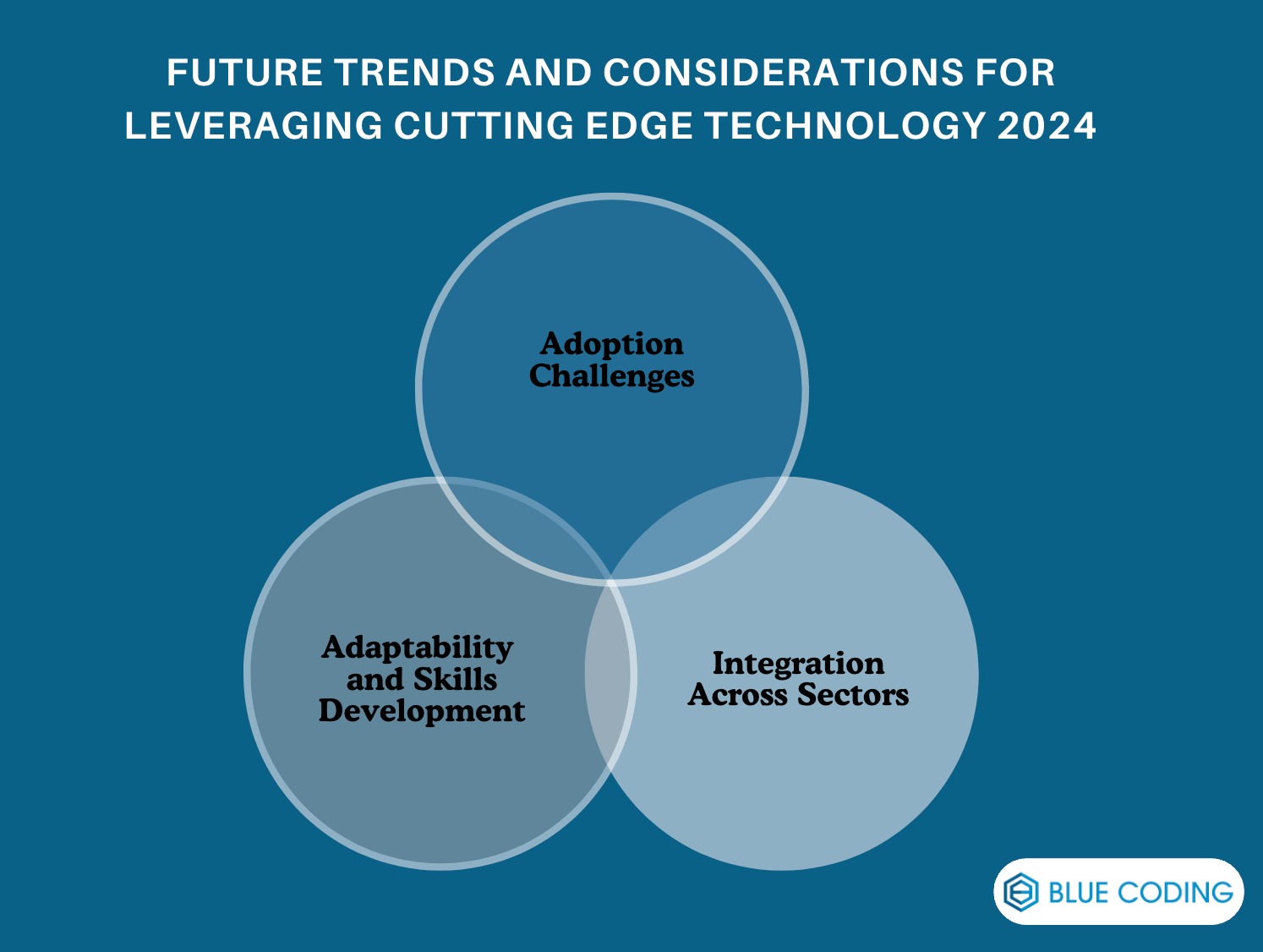 News
News
Technology is evolving at an unprecedented rate, reshaping industries like business, healthcare, finance, and our everyday lives. Innovations such as AI-driven automation, advanced connectivity, and sustainable tech solutions are not streamlining operations and transforming the entire landscape of how we work, live, and interact. Staying informed and leveraging the cutting edge technology trends is essential in today’s competitive world. Embracing these advancements allows businesses to thrive, individuals to stay relevant, and industries to grow and adapt.
This article will explore the most impactful technologies of 2024, providing insights into how they can be harnessed for growth, efficiency, and innovation. By understanding and implementing these advancements, businesses and individuals alike can gain a strategic edge in an increasingly tech-driven environment.
Artificial Intelligence and Machine Learning (AI/ML)
Current Advancements: AI and ML continue to evolve rapidly, with generative AI (such as ChatGPT and DALL-E), autonomous systems, and predictive analytics leading the charge. These technologies are driving innovation in areas like natural language processing, image generation, and real-time data analysis. Autonomous AI, particularly in robotics and transportation, is also making significant strides, enhancing operational efficiency and safety.
Applications: AI/ML is reshaping industries through personalized customer experiences, enhanced cybersecurity, predictive maintenance, and data-driven decision-making in manufacturing and finance. In healthcare, they are aiding in diagnostics, drug discovery, and patient monitoring.
Stats and Studies: AI adoption is accelerating globally. According to market projections, the AI industry is on track to reach an impressive $500 billion by 2024, reflecting a compound annual growth rate (CAGR) fueled by increased demand for AI-driven solutions across sectors. A recent survey indicates that nearly 77% of companies are now leveraging AI in some capacity, driven by its potential to increase revenue and reduce operational costs.
5G and Advanced Connectivity
Significance: 5G offers transformative speeds and reduced latency, which enhances the quality and reliability of internet connections. This faster, more stable connectivity powers innovations like real-time, high-volume data processing and low-lag communication, which is critical for next-gen applications.
Impacts on Industries: Sectors like autonomous vehicles, IoT, and smart cities benefit significantly from 5G. For autonomous cars, 5G enables rapid data transfer, improving reaction times. In smart cities, it supports a dense network of IoT devices, leading to efficient energy use and improved public services. 5G’s global economic impact is projected to exceed $1.3 trillion by 2030, with high adoption rates already observed in North America and Asia.
Beyond 5G: Future advancements include 6G, promising even higher speeds and ultra-low latency by 2030, and low-Earth-orbit satellites, expanding coverage to remote areas and enhancing global connectivity for advanced applications.
Blockchain and Decentralised Technologies
Beyond cryptocurrency, blockchain's transparency, security, and decentralized framework provide a robust solution for data authenticity and transactional trust, ideal for finance, supply chains, and data management.
New cutting-edge Trends: Decentralised finance (DeFi) is democratizing financial services without intermediaries. Additionally, NFTs are diversifying into industries beyond art, while decentralized autonomous organizations (DAOs) are gaining traction for transparent, collaborative decision-making. Companies like IBM and Walmart use blockchain for transparent supply chains and secure transactions, improving data accuracy and reliability. The blockchain market is expected to grow significantly, with projections suggesting a value of nearly $67 billion by 2026, underscoring its transformative industry impact.
Internet of Things (IoT) and Smart Devices
IoT is expanding rapidly, interlinking devices across homes, cities, and industries for seamless automation and monitoring. This interconnectedness allows for real-time data collection and smarter decision-making.
Industrial IoT (IIoT): In manufacturing, agriculture, and energy, IIoT is improving efficiency, reducing costs, and enabling predictive maintenance, which minimizes downtime and improves productivity. By 2025, the number of IoT-connected devices is projected to reach 75 billion, with the market valued at over $1.5 trillion. As IoT adoption rises, robust cybersecurity protocols are essential to safeguard data privacy and prevent breaches.
Edge Computing
Edge computing processes data closer to where it’s generated, reducing latency compared to traditional cloud computing by minimizing data transfer to central servers. This is critical for applications that require instant data processing. Edge computing supports real-time processing in autonomous vehicles, industrial automation, and live data analytics, enabling quicker responses to environmental changes.
Statistics: The edge computing market is anticipated to reach $87.3 billion by 2026 due to its rapid adoption across industries. Edge computing is set to integrate more deeply with IoT and AI, creating faster, more responsive systems that enhance device connectivity and processing.
Cybersecurity Innovations
With the rise of cyber threats, advanced cybersecurity measures are essential to protect sensitive data, systems, and devices. Innovations like AI-driven threat detection, zero-trust architectures, and biometric authentication are paving the way for more robust security protocols. AI-powered tools can proactively identify and mitigate risks, while zero-trust frameworks enhance security by verifying each access point.
Successful implementations, such as those in finance and healthcare, demonstrate the effectiveness of layered defenses. Investment in cybersecurity tech is projected to grow, focusing on enhanced AI, predictive analytics, and adaptive defense strategies.
Sustainable Tech Innovations
Green Technology Growth: Sustainable tech is rapidly advancing, including innovations in renewable energy sources like solar and wind, as well as energy-efficient devices designed to reduce carbon footprints. These solutions are essential as industries seek to align with global sustainability goals.
Circular Economy Technologies: Technologies promoting a circular economy—such as waste-reducing production processes and advanced recycling systems—are helping businesses reduce their environmental impact. Many companies, such as Tesla in renewable energy and Dell in recycling, are implementing green practices.
Stats and Data: The green tech sector is projected to grow substantially, with anticipated positive environmental impacts through increased efficiency and reduced waste. The market for green technology could reach over $44 billion by 2026, reflecting this surge in demand for eco-friendly solutions.
Future Trends and Considerations for Leveraging Cutting edge Technology 2024

Integration Across Sectors: The integration of various cutting-edge technologies is reshaping how industries operate. For instance, industries are increasingly using a blend of AI, IoT, and 5G to create smart, efficient systems. In the healthcare sector, AI-driven analytics can enhance patient care by integrating with IoT devices that monitor vital signs in real-time. This synergy not only improves operational efficiency but also enables businesses to offer innovative services and products, enhancing customer experiences and opening new revenue streams.
Adoption Challenges: While the potential of leveraging cutting-edge technologies is immense, organizations often face significant challenges. High initial costs can deter investments, especially for small and medium enterprises (SMEs) that may lack the necessary capital. Additionally, the rapid pace of technological change can create a skills gap, leaving companies struggling to find qualified professionals capable of managing and implementing these technologies. Regulatory hurdles also pose challenges, as businesses must navigate compliance with evolving laws and standards related to data security, privacy, and most cutting edge technology today use.
Adaptability and Skills Development: In this fast-evolving landscape, adaptability becomes a crucial trait for organizations and their workforce. Companies that prioritize continuous learning and development can better navigate the complexities of technological change. This means investing in training programs that enhance employees' skill sets and keep them up to date with emerging technologies. Organizations should foster a culture of innovation, encouraging teams to experiment and embrace change. This adaptability not only enhances organizational resilience but also positions businesses to leverage new technologies effectively, ensuring they remain competitive in their respective markets. By cultivating a workforce that is agile and well-equipped to handle technological advancements, companies can not only overcome challenges but also seize opportunities that arise from the integration of cutting-edge technologies.
Ready To Hire Remote Developers And Leverage The Best Cutting-edge Technologies?
We hope this article helped you see how the new cutting-edge technologies presents both opportunities and challenges. You should aim to invest in skills development and create adaptable structures if your goals is to better navigate the technological landscape of the future. For more details on how nearshore software development can help you achieve this, visit Blue Coding and schedule a free strategy call today!



